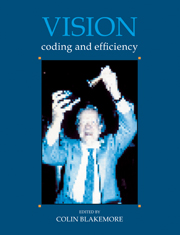Book contents
- Frontmatter
- Contents
- List of Contributors
- Preface
- Reply
- Acknowledgements
- Concepts of coding and efficiency
- Efficiency of the visual pathway
- Colour
- Brightness, adaptation and contrast
- 15 The role of photoreceptors in light-adaptation and dark-adaptation of the visual system
- 16 Why do we see better in bright light?
- 17 Mechanisms for coding luminance patterns: are they really linear?
- 18 Feature detection in biological and artificial visual systems
- Development of vision
- Depth and texture
- Motion
- From image to object
- Index
17 - Mechanisms for coding luminance patterns: are they really linear?
Published online by Cambridge University Press: 05 May 2010
- Frontmatter
- Contents
- List of Contributors
- Preface
- Reply
- Acknowledgements
- Concepts of coding and efficiency
- Efficiency of the visual pathway
- Colour
- Brightness, adaptation and contrast
- 15 The role of photoreceptors in light-adaptation and dark-adaptation of the visual system
- 16 Why do we see better in bright light?
- 17 Mechanisms for coding luminance patterns: are they really linear?
- 18 Feature detection in biological and artificial visual systems
- Development of vision
- Depth and texture
- Motion
- From image to object
- Index
Summary
Overview
One of the most powerful ideas in vision research in the last two decades has been the notion that luminance patterns are detected by independent linear mechanisms, which are selective for spatial frequency and orientation. This idea is consistent with psychophysical results from masking, sub-threshold summation, and adaptation studies. Moreover, physiological work on the striate cortex shows that simple cells are both linear, and selective for spatial frequency (Movshon et al., 1978) and orientation, making them a potential neural substrate for the detection mechanisms.
There are however some masking results which suggest that, even at modest contrasts, non-linearities may affect the mechanisms detecting luminance patterns.
The aim of this chapter is to present some physiological work which shows that non-linearities do indeed occur early in the visual pathway. A second aim is to show how it might be possible to remove the effects of these early non-linearities by cortical processing.
The chapter falls into four parts. The first part covers the background, describing some of the relevant psychophysical results. The second part describes the non-linear responses of X-cells in the lateral geniculate nucleus of the cat. The third part shows how the non-linear responses could be removed, to make linear receptive fields, like those of cortical simple cells. The final part discusses the implications and raises some unresolved issues.
Evidence for linear, spatial frequency-selective mechanisms
General
One key property of a linear mechanism is that it responds to a sinusoidal input with a sinusoidal output of the same frequency. Its response may differ in amplitude and phase from the input, but it will still be a sinusoid of the same frequency.
- Type
- Chapter
- Information
- VisionCoding and Efficiency, pp. 175 - 184Publisher: Cambridge University PressPrint publication year: 1991



